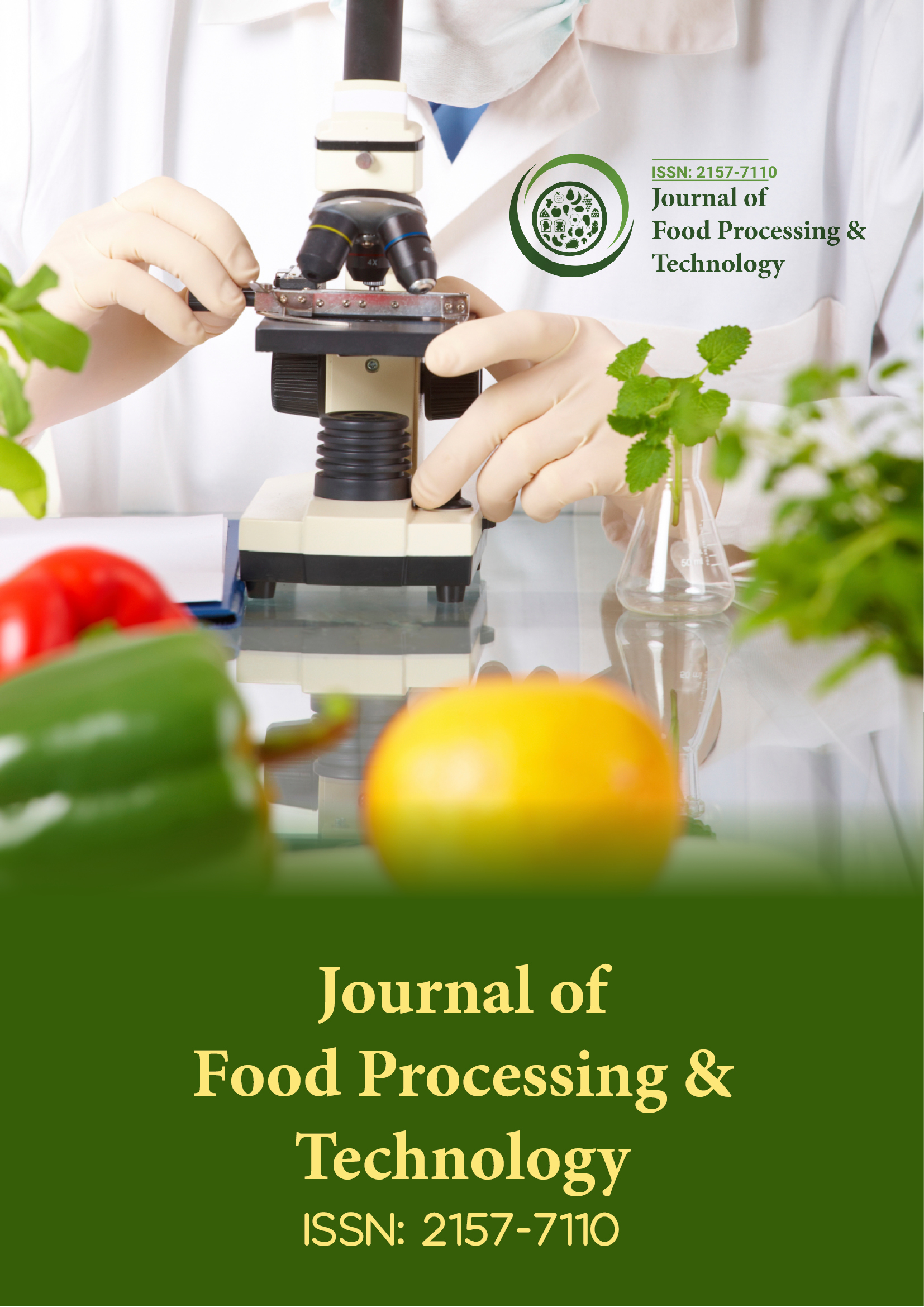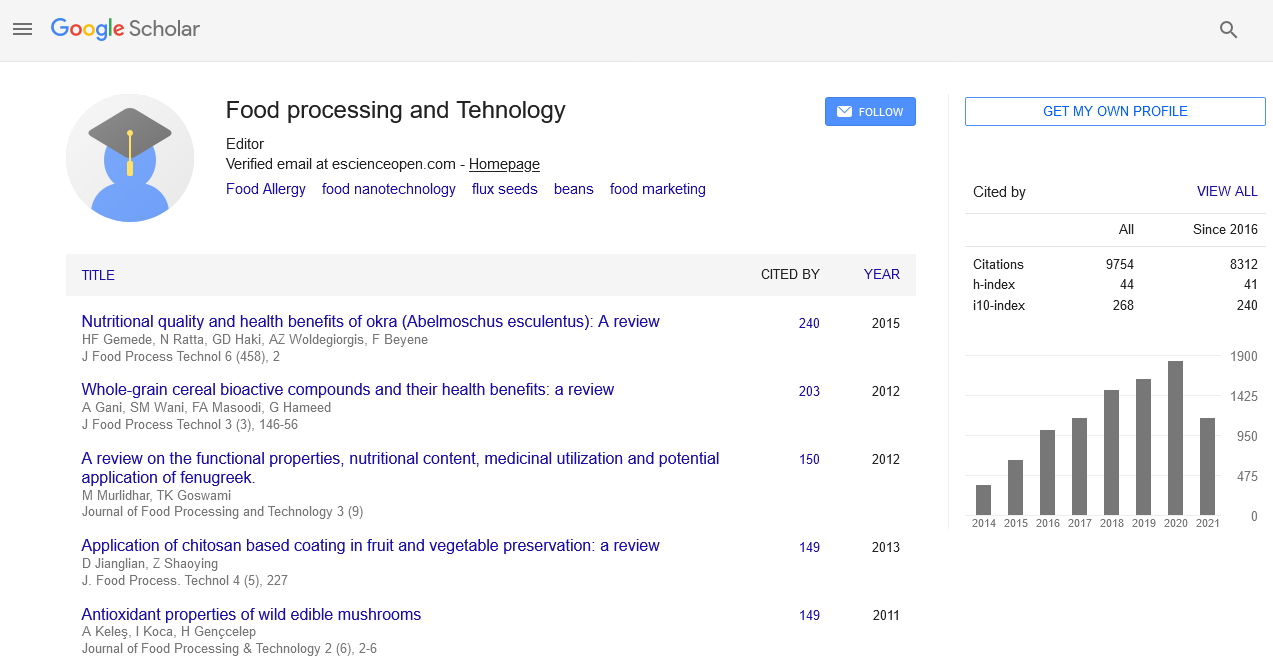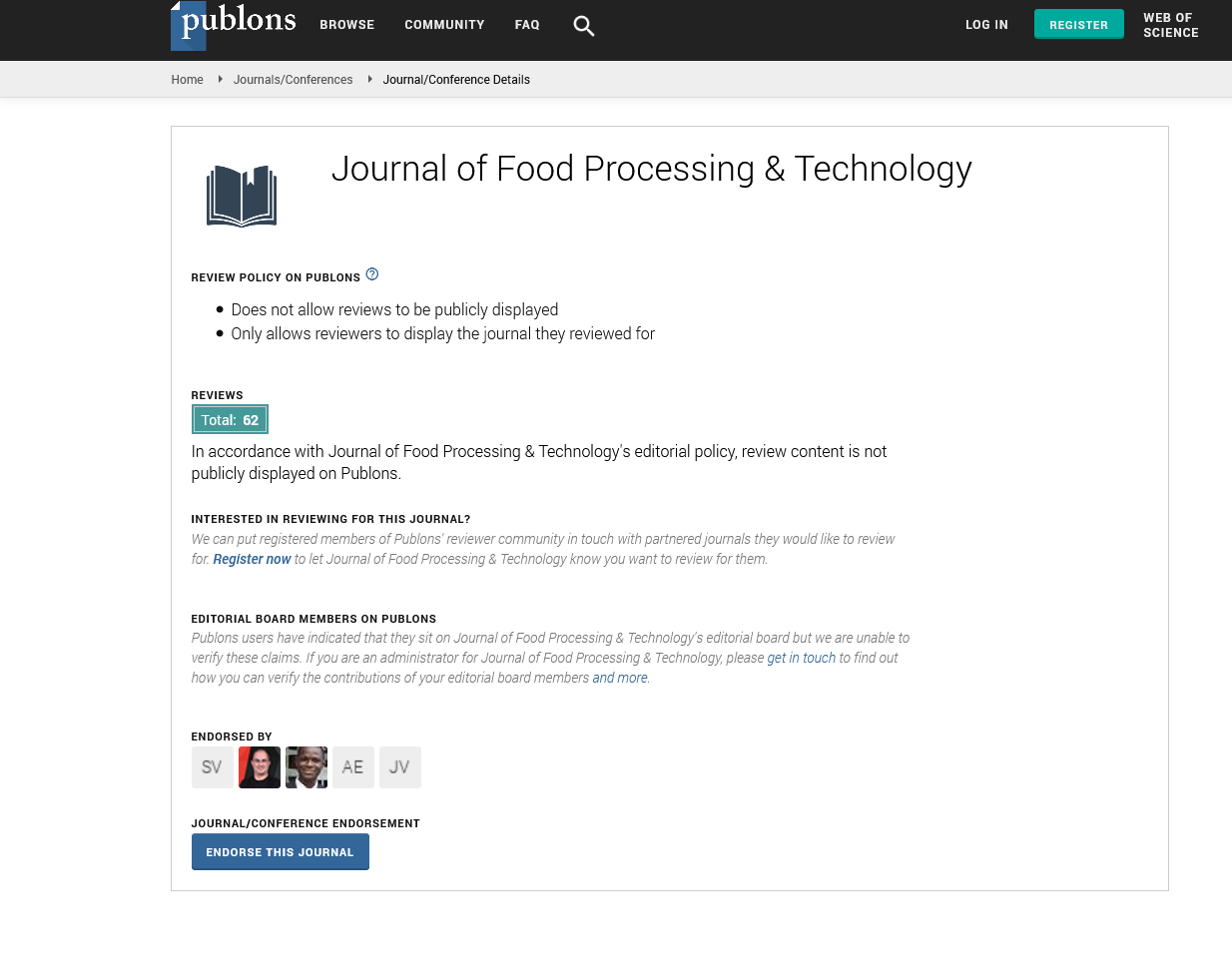Indexed In
- Genamics JournalSeek
- Academic Keys
- JournalTOCs
- China National Knowledge Infrastructure (CNKI)
- Access to Global Online Research in Agriculture (AGORA)
- Centre for Agriculture and Biosciences International (CABI)
- RefSeek
- Directory of Research Journal Indexing (DRJI)
- Hamdard University
- EBSCO A-Z
- OCLC- WorldCat
- Scholarsteer
- SWB online catalog
- Publons
- Euro Pub
- Google Scholar
Useful Links
Share This Page
Journal Flyer

Open Access Journals
- Agri and Aquaculture
- Biochemistry
- Bioinformatics & Systems Biology
- Business & Management
- Chemistry
- Clinical Sciences
- Engineering
- Food & Nutrition
- General Science
- Genetics & Molecular Biology
- Immunology & Microbiology
- Medical Sciences
- Neuroscience & Psychology
- Nursing & Health Care
- Pharmaceutical Sciences
Perspective - (2024) Volume 15, Issue 6
Informative Food Safety: Role of Cellular Fluorescence Imaging
Laura Ron*Received: 29-Nov-2024, Manuscript No. JFPT-24-28121; Editor assigned: 02-Dec-2024, Pre QC No. JFPT-24-28121 (PQ); Reviewed: 16-Dec-2024, QC No. JFPT-24-28121; Revised: 23-Dec-2024, Manuscript No. JFPT-24-28121 (R); Published: 30-Dec-2024, DOI: 10.35248/2157-7110.24.15.1136
Description
Cellular fluorescence imaging has emerged as a powerful tool in identifying and managing risks associated with food safety. As the global food supply chain becomes increasingly complex, ensuring the safety and quality of food products has become a top priority. This technology, which uses fluorescent markers to detect specific biological and chemical properties, provides a sophisticated method for addressing potential risks in the food industry. Fluorescence imaging operates by detecting light emitted from fluorophores, which are molecules that re-emit light upon excitation. These markers can be used to label cells, molecules, or pathogens in food samples, enabling precise detection of contaminants. The method’s sensitivity and ability to provide detailed visual information make it highly effective for applications such as microbial detection, quality assurance and authenticity verification.
One of the primary applications of this technology is identifying microbial contamination in food. Contaminants such as bacteria, fungi and viruses pose significant health risks to consumers and can result in widespread outbreaks if not identified early. Fluorescence imaging allows for the rapid detection and quantification of these microorganisms. By tagging bacteria with specific fluorescent markers, food producers and safety inspectors can quickly assess contamination levels and take corrective action. In addition to microbial detection, cellular fluorescence imaging is instrumental in assessing the quality of raw materials used in food production. For instance, it can detect degradation in produce caused by environmental factors such as excessive heat, humidity, or improper storage. These changes are often invisible to the naked eye but can be identified through fluorescence, which highlights alterations in cellular composition. Another significant advantage of fluorescence imaging is its application in detecting food scheme. The deliberate mislabeling or adulteration of food products not only misleads consumers but also poses health risks. For example, the addition of harmful dyes or the substitution of one ingredient for another can be identified through fluorescence markers. This ensures that products meet regulatory standards and consumer expectations for quality and safety.
Chemical contamination is another area where this technology proves invaluable. Pesticide residues, heavy metals and other hazardous chemicals can enter the food chain during agricultural production or processing. Fluorescence imaging helps detect these contaminants at trace levels, ensuring that food products comply with safety regulations. This is particularly important for exports, where countries often have strict safety standards that must be met before products can enter their markets. The use of fluorescence imaging extends beyond contamination detection to include monitoring the effectiveness of food preservation techniques. Techniques such as freezing, drying, or vacuum packing are widely used to extend the shelf life of food. Fluorescence imaging allows for the assessment of these methods’ impact on the cellular structure and nutritional content of food, helping producers optimize their processes while maintaining quality. Scientists use fluorescence imaging to study how different processing methods affect food at a molecular level. This knowledge aids in developing new products, improving preservation methods and designing packaging that better protects food from external factors. Implementing fluorescence imaging in food safety does require addressing certain challenges. The cost of equipment and the need for specialized training can be barriers, particularly for small-scale producers. Additionally, ensuring the accuracy of results depends on proper sample preparation and the use of suitable fluorescent markers. Despite these hurdles, the long-term benefits of improved safety and quality far outweigh the initial investment. To make this technology more accessible and manufacturers are working on developing compact and cost-effective fluorescence imaging devices. Advances in artificial intelligence and machine learning are also enhancing the interpretation of fluorescence data, allowing for automated and highly accurate analysis. These developments are expected to drive broader adoption of the technology across the food industry.
Collaboration among stakeholders is to maximizing the potential of fluorescence imaging. Governments, regulatory bodies and industry leaders must work together to establish standards and guidelines for its use. This will ensure consistency and reliability across the sector, fostering trust among consumers and trading partners. Public awareness of food safety technologies like fluorescence imaging is also essential. Educating consumers about how these methods contribute to safer and higher-quality food can increase demand for products tested with advanced technologies. This, in turn, motivates producers to adopt such practices, creating a positive cycle of improvement.
Cellular fluorescence imaging technology has significantly advanced the field of food safety by offering precise and efficient methods for detecting risks. Its applications in identifying microbial contamination, assessing quality and detecting chemical residues underscore its versatility and importance. While challenges remain in adoption and implementation, ongoing innovations and collaborative efforts are paving the way for broader use of this transformative technology. With continued investment and research, fluorescence imaging will play an increasingly vital role in securing the safety and integrity of our global food supply.
Citation: Ron L (2024). Informative Food Safety: Role of Cellular Fluorescence Imaging. J Food Process Technol. 15:1136.
Copyright: © 2024 Ron L. This is an open-access article distributed under the terms of the Creative Commons Attribution License, which permits unrestricted use, distribution, and reproduction in any medium, provided the original author and source are credited.


